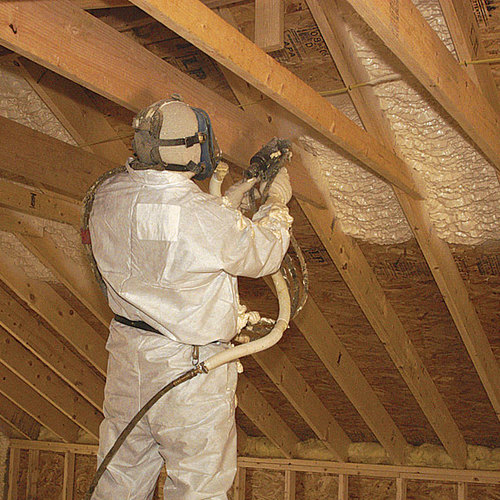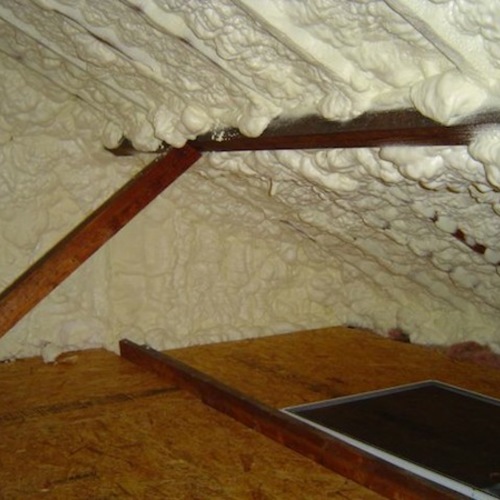
Image Credit: Nexus Green
Spray foam insulation evokes some interesting conversation among building scientists, construction professionals, environmentalists, and homeowners who have it in their homes. Many think it solves all problems, no matter how poorly it’s installed. Some think it’s helping to warm the planet and compromise the health of people and pets. In the middle are those who work with it regularly and see both the warts and the beauty of the product.
Building Science Corporation recently hosted its annual Experts’ Session, and the first day was all about spray foam insulation, with a collection of people who are mostly in the third camp mentioned above. Joe Lstiburek spoke first, and then introduced several experts to give us high-level information on this product — everything from the basics of open-cell versus closed-cell foam to the latest work on blowing agents.
The other invited speakers were:
- Mac Sheldon from Demilec
- Dr. Mark Bomberg, a building scientist who taught Joe
- Rick Duncan, PhD, PE, from the Spray Polyurethane Foam Alliance (SPFA)
- Xuaco Pascual and Mary Bogdan from Honeywell
- Paul Duffy from Icynene
A quick overview
Joe began by talking about the “perfect wall.” That led quickly to what he calls the 500-year wall, for three reasons: It represents 500 years of evolution; it lasts 500 years; and it takes clients 500 years to pay for it. He went through some of the details he presented in his “Perfect Wall” paper on the Building Science Corp. website, discussing where to use foam, which foam works, and how not to do stupid stuff.
Of course, he also took his jabs. (He called out ASTM at Summer Camp this year.) At the Experts’ Session, he said that ASTM stands for Another Stupid Test Method. He also continued the anti-WUFI campaign I first heard at the Passive House conference in Denver. In discussing how you decide what vapor permeability you want in your materials, he said, “You guess. I’ll trust your guess better than a WUFI analysis. WUFI should only be done with adult supervision.” (WUFI is a modeling tool for moisture and heat transport through building assemblies.)
An exploding truck
Mac Sheldon of Demilec gave a great talk titled “SPF Retrofit Problems & Solutions.” He discussed how controls have improved to the point where spray foam going off-ratio, while still possible, is becoming rare. He did show some of the problems that occur, including a scary photo of a box truck with the roof blown off because someone put water in the wrong drum. That drum ended up across the street.
Installer errors are the most frequent problems, and there’s been a concerted effort in the industry to improve in that area. Sheldon discussed the new accreditations and certifications that SPFA offers, and Rick Duncan went into a bit more detail about them. If you’re in the business of installing spray foam, get over to the SPFA website now and start getting your workers certified.
Don’t ever point your spray wand at human skin
The last speaker of the day was Paul Duffy of Icynene. He discussed some of the basics again and, as several other speakers had done, he hit the issue of safety pretty hard. “It’s going to be an obligatory part of SPF presentations from now on,” he said.
Duffy also gave the most jarring example of the day. To illustrate how much pressure the liquid is under when it comes out of the gun in a high-pressure SPF rig, he asked, “What do you think will happen if I aim a foam gun at my hand? It will inject foam under my skin and expand when it gets there.” Low-density, open-cell spray foam expands to 100 times its original volume very quickly, so imagine the Michelin Man on steroids.
Blowing agents and global warming potential
One of the big issues in the past couple of years has been the blowing agents used in spray polyurethane foam, specifically HFC-245fa used in closed-cell SPF. This whole thing blew up when Alex Wilson of Environmental Building News wrote a paper in 2010 in which he concluded that closed-cell SPF and extruded polystyrene (XPS) had too much global warming potential (GWP). He made his paper look like science when it wasn’t, and his analysis included so many assumptions that his results were not valid.
I wrote a response to his paper in August 2010, Don’t Forget the Science in Building Science, but more people read his paper than mine, and sadly, too many people believed his.
Yes, Alex did have a point about the blowing agents, and he should have just said that he didn’t like them instead of trying to calculate bogus “paybacks.” The good news for those who care about the GWP of materials is that the speakers from Honeywell announced their replacement for HFC-245fa, which they call Solstice Liquid Blowing Agent. It has a GWP of less than 5 (HFC-245fa is greater than 1000) and will be available starting in 2013.
The odor problem was only mentioned briefly
It was a great day packed with good information. In addition to what I mentioned above, the speakers also hit on the topics of ignition barriers, fires, lawsuits, and odors… briefly.
I like spray foam, but I’m also wary of some of the drawbacks. As with most of our technology, though, it works well when used appropriately and poorly when it’s not. It’s still true that the process is more important than the product. We need to get a lot more people in building science and construction to really understand what that means, and Joe’s day-long symposium on spray foam was a great way to help with that.
Allison Bailes of Decatur, Georgia, is a speaker, writer, energy consultant, RESNET-certified trainer, and the author of the Energy Vanguard Blog. You can follow him on Twitter at @EnergyVanguard.
Weekly Newsletter
Get building science and energy efficiency advice, plus special offers, in your inbox.















15 Comments
Hollow Article
Typical non-information article on GBA. The title really got my attention so I thought the article would contain useful information about "the latest thinking" spray foam insulation. Nothing useful here -- mostly blowing agents. The author should be allowed to write an in-depth and useful article about the information presented. Readers would be better served on the Building Science website.
Response to William Geary
I'm sorry you didn't find the article useful, but any lack of substance you perceive has nothing to do with a mandate from GBA. They allow me to write pretty much whatever I want, but I prefer to keep my articles shorter and let the comments be where more detailed discussion happens.
OK, Allison -- I'll bite
Allison,
So this is the comments section. This is where the detailed discussion can happen. Great.
So please, tell us what you learned when Joe shared "the latest thinking on this increasingly controversial topic." We want to know.
Spray Foam details
I agree there is oh so much more to cover, and for an experts session I would have liked to hear what Lstiburek actually said was a good use and proper install for spray foam. Any talk about the flash and batt system that is not an adequate thickness on the interior of the stud wall and condensation happening on the inside face and running down foam and rotting out sill plates ? How about Dr. Joe's famous "moisture sandwich" which closed cell foam can be if you have impervious layer on the other side? Or situations where only closed cell foam will work due to lower ceilings or shallow rafter bays?
Any one try recycling wood that has spray foam on it..... good luck.... I'll bet it ended up in the dumpster instead of the recycle/reuse pile. How about the code issues for fire and what happens when the stuff burns - rather toxic fumes.
Yes, warts and beauty. Maybe Bldg. Science Corp. will publish a paper summarizing this Expert's Session on spray foam since there is so much to cover !
Yes, more details
I agree that more information could be coming from GBA on spray foams. Rick Duncan made a presentation to an NAHB committee at the Fall Board meeting in Austin that was both fascinating and disconcerting. Disconcerting because of the amount information that was new to many of us who thought we knew a bit about spray foams. Blowing agents are just the tip of the iceberg. The whole phenomena of the "A" parts that are mixed with the "B" parts was quite revealing. Apparently there aren't that many manufacturers of "A" but there are a lot of "Bs" and many of them are proprietary to different companies and run the gamut from toxic to relatively benign. Except we builders and consumers don't know which is which. Another issue Rick brought up is the increasing use of foreign made "Bs" that may have questionable efficacy and toxicity. Caveat Emptor? OK, but let's get more information.
Perhaps and indepth overview would be timely. Anybody at GBA up to the task?
Response to Kim Shanahan
Kim,
Great suggestion. I'll add it to my list of upcoming topics.
Will it go round in circles?
I hadn't seen your response to Alex's article before, Allison. I was at the NESEA conference several years ago at the presentation that inspired his article - I could see his jaw dropping as the presentation went on. The irony of course is that it was given by Daniel Bergey of BSC. I can send you the powerpoint if you want it.
http://www.buildingscienceconsulting.com/who/bergey.aspx
Applying spray foam correctly
Budget permitting, spray foam is generally a no-brainer for us in Florida owing to the near-universal placement of the coldest air in the house (the 55*F degree stuff in R4-6 ducts) in the hottest volume of the house (attic). Moving the ductwork is rarely a viable retrofit option, so we go for foam.
We have learned that for foam to work properly, application thickness and uniformity take a back seat to achieving a proper air seal. Without the air seal, which means doing a proper job at the least accessible part of the attic, the sensible cooling load is reduced but the latent load remains untouched, leading to excessive humidity comfort complaints, and minimal energy savings, etc.
We have burned through several of our area's foam contractors. It is hard to get crews to buy into the fluttering digits on the blower door computer display, but filling the attic with theatrical smoke, flipping the blower door around to pressurize the house (10-20 Pa serves), and letting them see the gaps has been a winner.
It generally takes 3 or 4 iterations to close the gaps to an acceptable level since big gaps "steal" most of the smoke, obscuring smaller gaps.
We often set off smoke detectors. The Fire Dept has yet to show up, but it is only a matter of time. The most recent client told us that his smoke detectors were not centrally monitored...this turned out to be incorrect - the tightly gated community's security units showed up, disappointed at the lack of a real fire.
Foam done right is so effective that we strive to avoid "foam alone", that is applying spray foam without significantly downsizing the HVAC.
Yes, more info please
As an informed homeowner I was looking forward to many more details of this seminar. I realize it's a daunting task to summarize all the hours of the various presentations. Perhaps the videos can be made available as in the past. We are looking to create a sealed attic and while spray foam seems like the easiest most effective method, the recent info on GBA and elsewhere about its shortcomings and risks have stalled our plans. Perhaps some of us could volunteer to loosely transcribe portions of the presentations. I'd be good for let's say a two-hour slot if someone can get me access to the video.
Odour problems and other drawbacks
I too would like to see more informed discussion on the drawbacks. I like the concept of spray foam but it is the one technology that if you encounter a problem, it generally is going to be expensive and/or a hassle to correct. And because they don't want to have a serious discussion, that throws up a lot of red flags.
More on drawbacks of spray foam
The building industry has generally accepted that formaldehyde is a harmful additive. While the majority of people are not affected by formaldehyde, enough are that they are now restricting its use in some cases and providing more formaldehyde free products.
Like all the negative publicity from formaldehyde, i think the spray foam industry is entering a similar situation. It will only be a matter of time before governments step in and force the industry to confront the deficiencies of spray foam.
Done right
Done right, foam lets us reduce HVAC capacity by 1/3 or more, improve humidity control, and improve temperature control.
Foam helps us reduce a typical home's energy consumption, and as part of an integrated package of improvements we can reduce total energy consumption by 50% at a cost of $5-10 per square foot.
Foam Done right
If a link to view the entire presentation is not possible, I too volunteer as a scribe to pass on the pearls of the discussion. Telling subscribers about the great information presented then glossing over with a short summary is not disseminating facts to help us build smarter.
Foam sounds good, but so did thalidomide and Vioxx (medications that were considered break through agents that turned out to cause birth defects and heart disease, respectively).
...still waiting...Allison A. Bailes III, PhD, GBA Advisor,
...So please, tell us what you learned when Joe shared "the latest thinking on this increasingly controversial topic." We want to know....please? If not, please have someone else attend & write a meaningful article. Great tittle, but where is the info?
To those looking for more info...
I appreciate all the requests for more information from the session, but I'm afraid I can't help you much. I've looked at my notes and scoured my memory, and there's just not a whole lot I can add here. As I wrote toward the end of the article:
"[T]he speakers also hit on the topics of ignition barriers, fires, lawsuits, and odors... briefly."
Perhaps I should have taken more notes, but it seemed at the time there was a fair amount of overlap among speakers (new SPFA certifications, nature of SPF, safety...) and some of the material is already documented in other places. See, for example, BSC's paper on the perfect wall and SPFA's page on the new certifications.
I did find a couple of things in my notes that should have made it into the article, though:
Rick Duncan, PhD, PE, Technical Director of SPFA, told us that open-cell SPF has the same thermal properties of fibrous insulation and that the blowing agent is replaced by air very quickly. Also, 10% of the blowing agent in closed-cell SPF is released when it's sprayed and 25% of the blowing agent is released over a 50 year lifespan. He also said there's no significant VOC emissions from SPF and that MDI drops to safe levels within several hours of spraying. (Of course, that depends on the installer doing things correctly.)
Certainly I could have done a better job taking notes and giving more detailed information here because we had a whole day's worth of talks. I walked away from the session, though, wanting more information myself, and I've been looking into some of the questions. If you're on LinkedIn, there's been a really good discussion going on in the Building Science Community group on this issue. Look for the discussion I started with a link to my article on this topic.
Here's part of what Joe said in that discussion:
"There is no doubt that SPF's can work as air barrier materials, can work as part of air barrier assemblies, and can work as part of air barrier enclosures. However, using these "accepted" performance specs tested according to the relevant ASTM test protocols is not enough. The judgement of the designer of the enclosure and the skill and judgement of the applicator are also key. That was one of the intended messages of the Expert Session.
"Your comments on the ability of SPF to act as a sealant is significant and typically missed by the industry when it is not being misunderstood by the industry. I am particularly troubled when SPF is used as a 'sealant' between a window and window opening. I do not believe that it can perform this function for many of the reasons that you imply."
Finally, I'll be writing more about SPF, including a followup article on the blowing agent topic that Alex Wilson opened up in 2010. As Joe said in that LinkedIn discussion, "The SPF industry appears to be a victim of its own success."
Log in or create an account to post a comment.
Sign up Log in